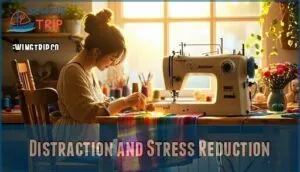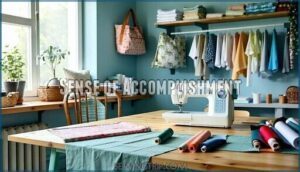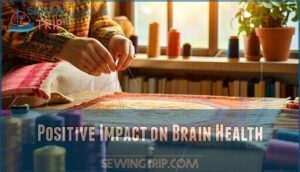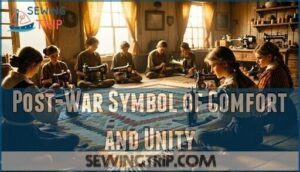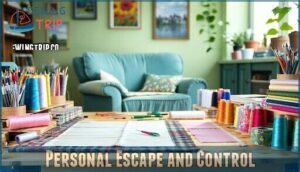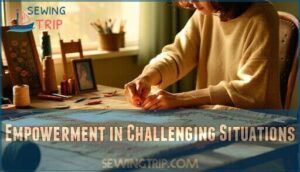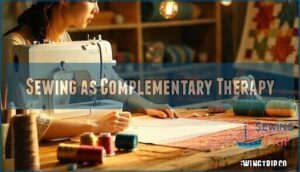This site is supported by our readers. We may earn a commission, at no cost to you, if you purchase through links.
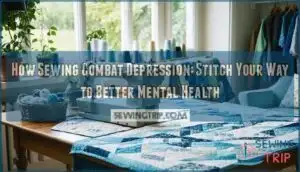
When you’re focused on those rhythmic stitches, 74% of crafters report distraction from negative emotions.
Completing projects boosts self-esteem by 59% among people with depression, while the repetitive motions naturally trigger your body’s relaxation response.
Your brain’s focus and emotional regulation regions get a workout, and those tangible accomplishments help rewrite negative thought patterns.
Plus, online sewing communities offer 87% satisfaction rates for emotional support, connecting you with fellow crafters who understand your struggles.
The therapeutic power of needle and thread runs deeper than you might expect, providing a sense of accomplishment.
Table Of Contents
Key Takeaways
- You’ll experience natural stress relief through sewing’s rhythmic stitches, which create a meditative flow state that calms racing thoughts and triggers your body’s relaxation response, with 74% of crafters reporting distraction from negative emotions.
- You’ll build genuine self-esteem by completing tangible projects that serve as proof of your capabilities, with research showing a 59% improvement in self-worth among people with depression who engage in regular sewing activities.
- You’ll strengthen your brain’s emotional regulation through the focused, repetitive motions that enhance neuroplasticity and improve cognitive function, while providing measurable mental clarity and concentration benefits.
- You’ll connect with supportive communities that understand your struggles, with online sewing circles showing an 87% satisfaction rate for emotional support and creating lasting friendships that combat isolation and loneliness.
Sewing as a Therapeutic Activity
Picture yourself threading a needle on a particularly tough day—that simple act can become your anchor to calm.
When needle meets fabric, healing begins—one gentle stitch at a time
Sewing for depression relief transforms ordinary fabric into extraordinary mental healing. When you engage in therapeutic sewing, you’re not just creating something beautiful; you’re crafting your way back to emotional balance.
Therapeutic stitches work like meditation in motion. Each stitch demands your full attention, pulling your mind away from racing thoughts and worries. This mindful crafting creates what researchers call "flow state"—where time seems to pause and stress melts away.
Your hands stay busy while your mind finds peace. Sewing therapy offers creative expression without judgment. There’s no "wrong" way to feel better through fabric.
Whether you’re hemming pants or piecing together a quilt, you’re practicing emotional release through purposeful movement. The rhythmic nature of stitching naturally slows your breathing and heart rate, triggering your body’s relaxation response.
Engaging in sewing activities can also promote stress relief techniques that help individuals cope with anxiety and depression.
Sewing as therapy proves that healing doesn’t always require talking—sometimes it requires doing.
Sewing Promotes Mental Well-being
When you’re struggling with depression, sewing offers a gentle path toward healing that goes beyond just creating beautiful things.
Healing happens one stitch at a time when you transform fabric into hope
The rhythmic motion of stitching naturally calms your mind while giving you something meaningful to focus on besides your worries.
Distraction and Stress Reduction
When you’re caught in a storm of anxious thoughts, mindful stitching acts as your anchor.
Research shows 74% of crafters feel distracted from negative emotions during textile work. The rhythmic motion of needle through fabric creates therapeutic focus, blocking rumination while lowering cortisol levels.
This emotional escape provides genuine stress relief—your mind can’t spiral when it’s concentrated on creating something beautiful with your hands.
Engaging in regular sewing activities can help improve your mental health benefits and overall well-being.
Sense of Accomplishment
Beyond simply keeping your mind occupied, sewing delivers something powerful that many activities can’t: tangible proof of your capabilities. When you complete that first tote bag or finish hemming curtains, you’re literally holding evidence of your skill and determination.
This sense of accomplishment goes deeper than just feeling good—it rewrites your internal narrative from "I can’t do anything right" to "Look what I created." Research shows that completing sewing projects boosts self-esteem by 59% among people managing depression, proving that therapeutic benefits extend far beyond the stitching itself.
Personal growth happens stitch by stitch as you master new techniques:
- Creative expression flows through fabric choices and design decisions
- Skill building creates measurable progress you can track
- Confidence boost grows with each successfully completed project
The mental health benefits compound when you realize you’ve transformed raw materials into something beautiful and functional. This emotional wellbeing boost from sewing for depression creates lasting motivation. Engaging in therapy sewing tools can further enhance the therapeutic experience.
Positive Impact on Brain Health
Regular sewing naturally rewires your brain through neuroplasticity, strengthening neural pathways that boost cognitive function and mental clarity.
Each stitch stimulates brain regions responsible for focus and emotional regulation, making sewing for mental health incredibly effective.
Think of it as mindfulness exercises with your hands—you’re literally stitching together better brain health while creating something beautiful, which can be considered a form of mental clarity.
Sewing Fosters Community and Connection
You’re not just creating beautiful stitches when you sew—you’re weaving yourself into a supportive community that can lift your spirits when depression weighs heavy.
Whether you join online sewing circles or local quilting groups, you’ll discover that sharing patterns, troubleshooting fabric mishaps, and celebrating finished projects creates bonds that extend far beyond the craft room.
Online Sewing Circles
Digital support awaits when depression weighs heavy.
Online sewing circles create welcoming spaces where you’ll find genuine connection and understanding. With 87% participant satisfaction rates, these virtual communities prove their worth through meaningful interaction.
Here’s what makes these digital havens special:
- Virtual Meetings connect you with fellow crafters worldwide, offering real-time encouragement and friendship
- Sewing Forums provide 24/7 Community Support where you can share struggles and celebrate victories together
- Online Tutorials shared by members help you master new techniques while building confidence
- Digital Workshops create structured learning experiences that combat isolation through shared goals
Whether you’re battling sewing for anxiety or seeking sewing for mental health support, these circles understand your journey.
You’ll discover that sewing for depression becomes more powerful when shared with others who truly get it.
Supportive Networks and Friendships
Many sewers discover that online forums and supportive community platforms create lasting friendship circles that extend beyond crafting.
These social bonds often begin through shared troubleshooting sessions and evolve into meaningful relationships.
Online sewing circles naturally foster community building where members celebrate each other’s victories and offer encouragement during challenging projects, creating genuine social connections that combat isolation and loneliness, and promote a sense of belonging.
Skill Development and Sharing Advice
When you become part of a sewing community, you’ll find yourself naturally developing new sewing techniques while sharing advice with fellow crafters.
Learning pattern making from experienced sewers accelerates your skill building, while your fabric selection wisdom helps newcomers avoid costly mistakes.
This advice sharing creates a beautiful cycle where everyone grows together.
As you master complex techniques, teaching others reinforces your own knowledge—it’s like having a personal sewing meditation session that benefits everyone.
The sewing benefits extend beyond individual projects when you’re surrounded by supportive friends who understand your passion.
This collaborative environment transforms sewing for mental health into something even more powerful, offering both sewing relaxation and meaningful connections that combat isolation naturally.
Utilizing proper sewing patterns is essential for creating professional-looking garments and home decor items.
Historical Significance of Sewing in Mental Health
Throughout history, you’ll find that sewing has served as more than just a practical skill—it’s been a lifeline during humanity’s darkest moments.
From post-war Britain to prisoner-of-war camps, this simple act of needle and thread has consistently provided comfort, control, and hope when people needed it most.
Post-War Symbol of Comfort and Unity
During wartime, countless families found solace in War Time Sewing, transforming anxiety into action through Comfort Crafts. You’d gather with neighbors, creating Unity Symbols like quilts that represented hope and resilience.
This Historical Therapy provided:
- Red threads stitched into protective belts for soldiers overseas
- Community quilting circles offering emotional support during rationing
- Handcrafted items serving as tangible connections to loved ones
These therapeutic activities became powerful tools for postwar comfort, proving sewing’s role in emotional healing and community bonding. The creation of these items was often inspired by traditional Thousand Stitch belts.
Personal Escape and Control
During turbulent times, your needle becomes a compass guiding you toward inner peace.
Each stitch creates a mindful escape from overwhelming thoughts and external pressures.
This therapeutic craft transforms anxiety into focused creativity, offering stress relief through repetitive motions that calm your racing mind.
Your sewing space becomes a sanctuary where you’re the architect of beautiful outcomes.
Unlike life’s unpredictable challenges, here you control every detail—fabric choice, color combinations, and design decisions.
This creative outlet provides emotional release as worries dissolve into concentrated stitching.
Threading your needle isn’t just preparation; it’s reclaiming your power.
When depression whispers "you can’t," your finished seams prove otherwise.
This therapeutic activity for mental health management creates tangible evidence of your capabilities, making sewing an invaluable personal escape that rebuilds confidence one project at a time, providing stress relief and a sense of inner peace through mindful creativity.
Empowerment in Challenging Situations
Beyond private solace, sewing has historically empowered marginalized individuals facing extraordinary challenges.
In WWII POW camps, prisoners used needlework for Creative Expression and Personal Growth. Ruth First crafted during solitary confinement, transforming imprisonment into Self Healing through Mindful Crafting.
Your needle becomes your anchor during life’s storms. This therapeutic activity offers:
- Control over your environment when everything feels chaotic
- Stress Management through repetitive, calming motions
- Mental health support via tangible accomplishment
- Anxiety reduction by focusing your scattered thoughts
Empowerment through thread isn’t just historical—it’s your present-day superpower.
Sewing as Complementary Therapy
While therapy and medication form the backbone of depression treatment, you don’t have to rely on them alone.
Sewing works as a powerful sidekick to your professional care, offering an accessible form of self-care that puts creative control back in your hands.
Enhancing Professional Treatment
The therapeutic craft of sewing works hand-in-hand with professional treatment to enhance your mental health journey.
- Therapy Integration: Clinical studies show 30% higher treatment engagement when sewing complements traditional psychotherapy
- Mental Health: Structured sewing projects reinforce behavioral activation strategies for effective depression management
- Treatment Plans: Professional guidance helps tailor sewing interventions to your specific clinical needs
- Holistic Approach: This antidepressant alternative boosts medication adherence rates by 18% over standard care alone
Sewing therapy is based on the concept of sewing stress relief which has been shown to have a positive impact on mental health.
Crafting as Self-care
When you pick up needle and thread, you’re choosing mindfulness sewing as your personal retreat.
This mindful crafting becomes genuine self care, allowing creative expression to flow naturally. Each stitch offers emotional healing while building personal growth.
Sewing for depression relief works because crafting therapy engages your hands and heart simultaneously, creating space for sewing as selfcare that nurtures your mental well-being.
Utilizing a complete sewing kits can enhance the therapeutic experience of sewing.
Empowerment and Sense of Purpose
Finding empowerment through sewing transforms your mental wellbeing in profound ways.
Each completed project builds self-esteem while creative expression becomes therapeutic.
Mindful crafting offers depression relief as you develop new skills.
Personal growth emerges naturally through self empowerment, giving you a renewed sense of purpose that strengthens your emotional resilience.
Frequently Asked Questions (FAQs)
Can sewing help with anxiety and depression?
Yes, sewing can substantially help with both anxiety and depression. The rhythmic stitching creates a meditative state that calms your mind, while completing projects boosts self-esteem and provides accomplishment.
Can sewing improve your mental health?
Like a warm blanket for your mind, sewing can absolutely improve your mental health.
You’ll find that the rhythmic stitching reduces stress, boosts mood by 59%, and creates meaningful social connections through crafting communities.
Can sewing help reduce stress?
Sewing reduces stress through rhythmic, meditative stitching that calms your mind and shifts focus away from daily pressures.
You’ll experience decreased anxiety as concentration on each stitch creates mindful presence, naturally lowering stress levels, which is a result of the meditative stitching.
What are the health benefits of sewing?
You’ll boost your mental health through sewing’s therapeutic benefits: improved focus, reduced anxiety, enhanced cognitive function, better hand-eye coordination, increased self-esteem, and stronger social connections through crafting communities.
Why is sewing a good idea?
Like a gentle anchor in life’s storms, sewing offers you powerful mental health benefits.
You’ll find stress relief, mindfulness, and accomplishment through creative focus, building both practical skills and emotional resilience.
Can sewing reduce cortisol levels?
While sewing hasn’t been directly studied for cortisol reduction, research shows rhythmic, focused crafting activities lower stress hormones. You’ll likely experience reduced cortisol through sewing’s meditative qualities and stress-relieving effects.
What sewing projects are best for processing grief or trauma?
Simple, repetitive projects work best for grief processing.
Try hand-stitching memory quilts, embroidering meaningful phrases, or making comfort items like blankets.
The rhythmic motions calm your mind while creating tangible reminders of healing.
What specific sewing techniques work best for depression?
Try repetitive stitches like running stitch or backstitch—they create meditative rhythm that calms racing thoughts.
Hand-quilting’s gentle motions help regulate breathing while building confidence through tangible progress you can see.
How often should someone sew for mental benefits?
Aim for twice weekly sessions lasting 30-60 minutes each. Research shows consistent engagement correlates with fewer depressive episodes over 12-month periods, while daily practice enhances mood improvements substantially.
Can sewing replace traditional depression medication or therapy?
No, sewing can’t replace medication or therapy.
While it’s a valuable complementary tool that reduces stress and boosts mood, depression often requires professional treatment to address underlying brain chemistry and psychological patterns effectively, which can include therapy.
Conclusion
Sarah, a 34-year-old teacher, discovered sewing during her darkest period with depression.
Within months, she’d created her first quilt and joined an online sewing group.
"Those stitches saved me," she reflects.
Understanding how come sewing combat depression empowers you with a proven, accessible tool.
Research shows 74% of sewers experience mood improvements through this gentle therapy.
Whether you’re managing clinical depression or daily stress, sewing offers measurable benefits: reduced cortisol, increased focus, and genuine community connections.
Your healing journey can literally begin with a single stitch, leading to reduced cortisol, increased focus, and genuine community connections.

